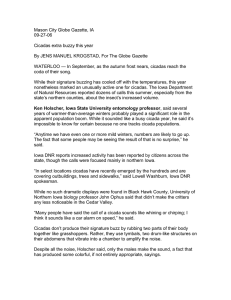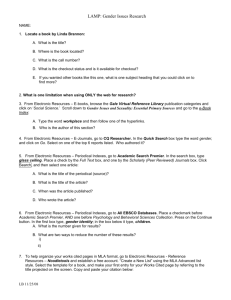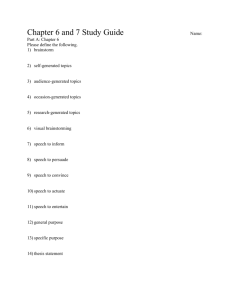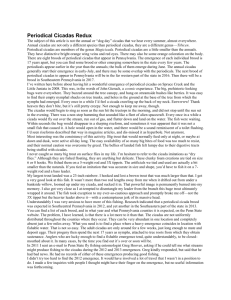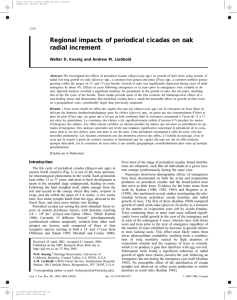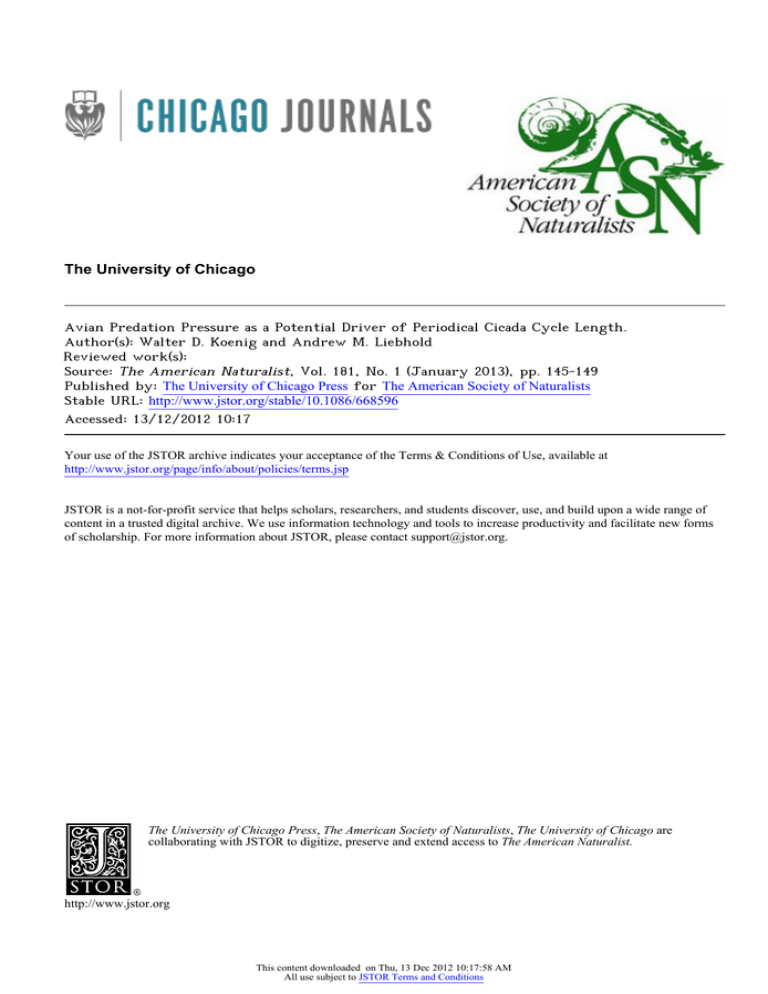
The University of Chicago
Avian Predation Pressure as a Potential Driver of Periodical Cicada Cycle Length.
Author(s): Walter D. Koenig and Andrew M. Liebhold
Reviewed work(s):
Source: The American Naturalist, Vol. 181, No. 1 (January 2013), pp. 145-149
Published by: The University of Chicago Press for The American Society of Naturalists
Stable URL: http://www.jstor.org/stable/10.1086/668596 .
Accessed: 13/12/2012 10:17
Your use of the JSTOR archive indicates your acceptance of the Terms & Conditions of Use, available at .
http://www.jstor.org/page/info/about/policies/terms.jsp
.
JSTOR is a not-for-profit service that helps scholars, researchers, and students discover, use, and build upon a wide range of
content in a trusted digital archive. We use information technology and tools to increase productivity and facilitate new forms
of scholarship. For more information about JSTOR, please contact support@jstor.org.
.
The University of Chicago Press, The American Society of Naturalists, The University of Chicago are
collaborating with JSTOR to digitize, preserve and extend access to The American Naturalist.
http://www.jstor.org
This content downloaded on Thu, 13 Dec 2012 10:17:58 AM
All use subject to JSTOR Terms and Conditions
vol. 181, no. 1
the american naturalist
january 2013
Natural History Note
Avian Predation Pressure as a Potential Driver of
Periodical Cicada Cycle Length
Walter D. Koenig1,* and Andrew M. Liebhold2
1. Cornell Lab of Ornithology, Ithaca, New York 14850; and Department of Neurobiology and Behavior, Cornell University, Ithaca, New
York 14853; 2. USDA Forest Service, Northern Research Station, 180 Canfield Street, Morgantown, West Virginia 26505
Submitted February 13, 2012; Accepted August 2, 2012; Electronically published November 27, 2012
Dryad data: http://dx.doi.org/10.5061/dryad.b6k41.
abstract: The extraordinarily long life cycles, synchronous emergences at 13- or 17-year intervals, and complex geographic distribution of periodical cicadas (Magicicada spp.) in eastern North
America are a long-standing evolutionary enigma. Although a variety
of factors, including satiation of aboveground predators and avoidance of interbrood hybridization, have been hypothesized to shape
the evolution of this system, no empirical support for these mechanisms has previously been reported, beyond the observation that
bird predation can extirpate small, experimentally mistimed emergences. Here we show that periodical cicada emergences appear to
set populations of potential avian predators on numerical trajectories
that result in significantly lower potential predation pressure during
the subsequent emergence. This result provides new support for the
importance of predators in shaping periodical cicada life history,
offers an ecological rationale for why emergences are synchronized
at the observed multiyear intervals, and may explain some of the
developmental plasticity observed in these unique insects.
Keywords: Magicicada, periodical cicadas, periodicity, population cycles, predator satiation.
Introduction
Periodical cicadas (Magicicada spp.) have the longest life
span of any insect. Sufficiently spectacular as to be noted
by early American colonists (Oldenburg 1666), 15 different
“broods”—single-aged, mostly nonoverlapping cohorts
that develop asynchronously with other populations—are
currently known, each of which is composed of three or
four coexisting species (Marlatt 1907; Simon 1988; Williams and Simon 1995). Satiation of aboveground predators has been considered the most important driver of
the synchronous emergences observed in this system since
studies in the nineteenth century demonstrated the potential for avian predators to extirpate populations induced
* Corresponding author; e-mail: wdk4@cornell.edu.
Am. Nat. 2013. Vol. 181, pp. 145–149. 䉷 2012 by The University of Chicago.
0003-0147/2013/18101-53657$15.00. All rights reserved.
DOI: 10.1086/668596
to emerge out of phase with the main brood present in a
region (Marlatt 1907; May 1979).
The factors driving the extraordinary length of periodical cicada cycles has proved more elusive. Various hypotheses have been proposed, including interactions with
long-lived parasitoids (Lloyd and Dybas 1966a, 1966b),
belowground intra- or interspecific competition (Bulmer
1977; Grant 2005), and avoidance of hybridization (Cox
and Carlton 1988), the latter of which has been found
theoretically to be facilitated by cycles that are prime-numbered years in length (Goles et al. 2000; Webb 2001; Tanaka
et al. 2009; Yoshimura et al. 2009). Despite this plethora
of ideas, no empirical basis for 13- or 17-year cycles has
previously been detected (Grant 2005; Lehmann-Ziebarth
et al. 2005).
We investigated the interaction between periodical cicada emergences and the combined estimated potential
predation pressure of 15 avian species that have been
shown to be affected by periodical cicada emergences, either because population counts were significantly related
to years since emergence in statistical models or because
populations changed significantly the year before or the
year after emergences (table 1; Koenig and Liebhold 2005).
Rather than focusing on the bird populations per se, here
we estimate the potential predation pressure of those bird
populations on cicadas and, in particular, how it is related
to the periodical cicada cycle.
Material and Methods
Data on relative avian population sizes over a 45-year
period (1966–2010; this extends the data used by Koenig
and Liebhold [2005] by 8 years) were obtained from the
North American Breeding Bird Survey (http://www
.pwrc.usgs.gov/bbs/). We included all 15 species (out of
the 24 insectivorous species examined initially by Koenig
and Liebhold [2005]) whose populations had previously
been shown to be affected by periodical cicada emergences,
This content downloaded on Thu, 13 Dec 2012 10:17:58 AM
All use subject to JSTOR Terms and Conditions
146 The American Naturalist
Table 1: Bird species included in the analyses
Species
Yellow-billed cuckoo
Black-billed cuckoo
Red-headed woodpecker
Red-bellied woodpecker
Blue jay
American crow
Brown-headed cowbird
Common grackle
Northern cardinal
House sparrow
Northern mockingbird
Gray catbird
Brown thrasher
Tufted titmouse
Wood thrush
Scientific name
Mean body mass (g)
Coccyzus americanus
Coccyzus erythropthalmus
Melanerpes erythrocephalus
Melanerpes carolinus
Cyanocitta cristata
Corvus brachyrhynchos
Molothrus ater
Quiscalus quiscula
Cardinalis cardinalis
Passer domesticus
Mimus polyglottos
Dumetella carolinensis
Toxostoma rufum
Baeolophus bicolor
Hylocichla mustelina
64.0
51.1
71.6
61.7
86.8
448.0
43.9
113.5
44.7
27.7
48.5
36.9
68.8
21.6
47.7
Note: Included are insectivorous species whose populations exhibit evidence of being affected
by periodical cicada emergences based on previous analyses (Koenig and Liebhold 2005).
either because population counts were significantly related
to years since emergence in general linear models or because populations had changed significantly in the year
before or the year after emergences. For each species, we
calculated mean numbers of birds (untransformed)
counted at each Breeding Bird Survey route, after detrending within routes to eliminate long-term trends. We then
summed detrended numbers of birds for each of the 15
species in each year, weighting species values by their estimated field metabolic rate (where field metabolic rate p
10.5 # (mean body mass)0.681; Nagy 2005), under the assumption that depredation of cicadas will be related to
each species’s total metabolic rate.
Sites were matched to the emergences of specific cicada
broods by means of a geographic information system and
brood boundaries based on county-level maps (Marlatt
1907; Simon 1988), after which data were standardized by
year of the cicada life cycle. That is, within sites, we averaged values for each avian species during year 0 (emergence year), year 1, year 2, and so on, through either year
12 (within the range of 13-year broods) or year 16 (within
the range of 17-year broods). Values were then standardized to a mean of 0 and a standard deviation of 1, so that
each site was weighted equally, and averaged across all sites
within the range of periodical cicada broods. Results were
determined for birds living within the ranges of 13- and
17-year broods separately and were restricted to sites that
fell within the nonoverlapping range of a single brood.
Only sites with data for a complete cycle were included.
Sample sizes (number of sites) were N p 238 (17-year
broods) and N p 138 (13-year broods).
Differences in mean estimated potential predation pressure relative to the local cicada life cycle were tested with
repeated-measures general linear models. Statistical significance was based on linearly independent pairwise comparisons among the estimated marginal means and was
performed in SPSS (SPSS 1999). Values were divided by
their standard errors for plotting.
Results
For both 13- and 17-year broods, estimated potential predation pressure was significantly depressed during emergence years (fig. 1). In the years between emergences, potential predation pressure within the range of 13-year
broods exhibited a numerical increase immediately after
emergences, followed by a crash in year 4. Values again
dipped in year 10 and during the thirteenth (emergence)
year. Within the range of 17-year broods, potential predation pressure following emergences underwent a single
long, slow increase peaking in year 12, after which it declined, reaching a nadir in the seventeenth (emergence)
year.
Three explanations for the significantly low predator
populations recorded during emergence years include (1)
birds are less detectable because of the high densities and
loud mating calls of cicadas; (2) cicada calls impair normal
communication and drive birds away from emergence areas (Simmons et al. 1971); and (3) low numbers are the
consequence of long-lasting demographic processes initiated by the previous emergence event (Koenig and Liebhold 2005). Prior analyses specifically testing these alternatives indicate that avian populations are also reduced
during emergence years in populations located within the
geographic range of broods, but in areas where cicadas are
not chorusing, thus rejecting the first two hypotheses and
This content downloaded on Thu, 13 Dec 2012 10:17:58 AM
All use subject to JSTOR Terms and Conditions
Avian Predation and Periodical Cicadas 147
4
2
Relative predation pressure
A
●
0
−2
−4
●
●
−6
0
1
2
3
4
5
6
7
8
9 10
12
14
16 0
4
2
B
●
●
0
−2
−4
●
●
●
●
−6
0
1
2
3
4
5
6
7
8
9
10
11
12
0
Years postemergence
Figure 1: Mean (Ⳳ2 SE) estimated potential predation pressure on periodical cicadas during each year of the 13- or 17-year life cycle,
based on 15 bird species whose populations were related to the periodical cicada cycle (table 1; Koenig and Liebhold 2005): A, 17-year
broods; B, 13-year broods. In both panels, the Y-axis plots deviations (in SE) from the overall mean, and values are averaged across all
years of data. Year 0 (emergence year) is plotted at both the beginning and the end of the cycle. Circles represent statistically significant
values (open: P ! .05; filled: P ! .01).
providing support for the hypothesis that low predation
pressure is due to factors initiated during the prior, rather
than current, emergence (Koenig et al. 2011).
Discussion
Predator satiation by periodical cicadas has long been
thought to play a key role in causing periodicity and maintaining population synchrony of periodical cicadas (Lloyd
and Dybas 1966b; May 1979; Itô 1998; Hayes 2004). Our
results confirm that avian populations do not (or are unable to) track emergences by either maintaining high populations in between emergences—a key assumption of at
least one prior model of periodical cicada periodicity
(Hoppensteadt and Keller 1976)—or increasing their populations in anticipation of the abundant prey base available
during (and only during) emergence events. More surprising is the finding that potential predation pressure on
cicadas is significantly reduced during emergence years.
That these years of low predation pressure coincide with
cicada emergences suggests that predator satiation, besides
being an important synchronizing factor, may play a role
in the evolution of cycle length by instigating a multiyear
numerical response in bird populations that ultimately
benefits adult cicada survival.
Given their lack of defenses against avian predators
(Williams and Simon 1995), it is clearly advantageous for
cicadas to emerge when potential predation is relatively
low. Furthermore, individuals in 13-year broods that fail
to emerge on schedule would benefit by delaying emergence by 4 years, when potential predation pressure will
have declined from the increase it experienced after emergence (fig. 1B). The patterns of potential predation pressure indicated by our results thus offer an ecological rationale for at least some of the developmental plasticity
observed in periodical cicadas, in particular the recently
documented 4-year-delayed emergences that have been hypothesized to be the evolutionary mechanism by which
new broods form (Marshall et al. 2011).
Periodical cicada emergences have previously been
This content downloaded on Thu, 13 Dec 2012 10:17:58 AM
All use subject to JSTOR Terms and Conditions
148 The American Naturalist
shown to create a significant resource pulse influencing
nutrient flux (Whiles et al. 2001; Yang 2004), plant and
tree growth (Karban 1980; Koenig and Liebhold 2003; Yang
2004), small mammals (Krohne et al. 1991; Marcello et
al. 2008; Vendegrift and Hudson 2009), and both longterm population size and spatial synchrony of bird populations (Koenig and Liebhold 2005). Results reported
here extend those findings, suggesting that the extraordinary life cycle of periodical cicadas may “engineer” bird
populations in a way that keeps them from tracking emergences, not by their extreme length or as a consequence
of being prime numbered, but rather by setting bird populations on a trajectory such that the subsequent emergence coincides with reduced predation pressure.
The mechanism by which this is accomplished is unknown, and indeed it seems remarkable that bird densities
could be influenced more than a decade later by a single,
relatively short-lived event. One possible explanation
comes from work demonstrating that emergences cause
substantial pulsed enrichment of forest soils, with both
corresponding direct effects belowground and indirect effects aboveground (Yang 2004). That such resource pulses
can have long-lasting effects cascading through communities is now well established (Jones et al. 1998; Ostfeld
and Keesing 2000), although no previous system has been
suggested to have effects lasting as long as those found
here. Another possibility is that numerical interactions
with alternative avian prey species, such as foliage-feeding
caterpillars, several of which exhibit regular multiyear cycles (Myers 1988), might mediate the long-term changes
in bird populations that are driving the patterns found
here.
Clearly, many mysteries remain regarding periodical
cicada biology (Hayes 2004). Although considerable progress has been made in recent years investigating the patterns of speciation (Cooley et al. 2001) and the evolutionary history (Yoshimura 1997; Grant 2005) of this
group, much remains to be discovered concerning how
modern-day ecological factors affect periodical cicada populations. Results shown here suggest that avian predators—long thought to be key to synchronizing emergence
events—may play a key role in several of the difficult-toexplain life-history features of these extraordinary insects.
The role of other ecological factors, including predation
by small mammals, parasites, and reductions in forest productivity in emergence years, remain to be examined
empirically.
Acknowledgments
We thank J. Dickinson, R. Karban, L. Ries, K. Williams,
T. Yamanaka, and the reviewers for comments, along with
D. Bystrack, S. Droege, and all those involved in the North
American Breeding Bird Survey. Incidental support came
from National Science Foundation grant IOS-0918944 to
W.D.K.
Literature Cited
Bulmer, M. G. 1977. Periodical insects. American Naturalist 111:
1099–1117.
Cooley, J. R., C. Simon, D. C. Marshall, K. Slon, and C. Ehrhardt.
2001. Allochronic speciation, secondary contact, and reproductive
character displacement in periodical cicadas (Hemiptera: Magicicada spp.): genetic, morphological, and behavioural evidence.
Molecular Ecology 10:661–671.
Cox, R. T., and C. E. Carlton. 1988. Paleoclimatic influences in the
evolution of periodical cicadas (Insecta: Homoptera: Cicadidae:
Magicicada spp.). American Midland Naturalist 120:183–193.
Goles, E., O. Schulz, and M. Markus. 2000. A biological generator
of prime numbers. Nonlinear Phenomena in Complex Systems 3:
208–213.
Grant, P. R. 2005. The priming of periodical cicada life cycles. Trends
in Ecology & Evolution 20:169–174.
Hayes, B. 2004. Bugs that count. American Scientist 92:401–405.
Hoppensteadt, F. C., and J. B. Keller. 1976. Synchronization of periodical cicada emergences. Science 194:335–337.
Itô, Y. 1998. Role of escape from predators in periodical cicada (Homoptera: Cicadidae) cycles. Annals of the Entomological Society
of America 91:493–496.
Jones, C. G., R. S. Ostfeld, M. P. Richard, E. M. Schauber, and J. O.
Wolff. 1998. Chain reactions linking acorns to gypsy moth outbreaks and Lyme disease risk. Science 279:1023–1026.
Karban, R. 1980. Periodical cicada nymphs impose periodical oak
tree wood accumulation. Nature 287:326–327.
Koenig, W. D., and A. M. Liebhold. 2003. Regional impacts of periodical cicadas on oak radial increment. Canadian Journal of
Forest Research 33:1084–1089.
———. 2005. Effects of periodical cicada emergences on abundance
and synchrony of avian populations. Ecology 86:1873–1882.
Koenig, W. D., L. Ries, V. B. K. Olsen, and A. M. Liebhold. 2011.
Avian predators are less abundant during periodical cicada emergences, but why? Ecology 92:784–790.
Krohne, D. T., T. J. Couillard, and J. C. Riddle. 1991. Population
responses of Peromyscus leucopus and Blarina brevicauda to emergence of periodical cicadas. American Midland Naturalist 126:317–
321.
Lehmann-Ziebarth, N., P. P. Heideman, R. A. Shapiro, S. L. Stoddart,
C. C. L. Hsiao, G. R. Stephenson, P. A. Milewski, and A. R. Ives.
2005. Evolution of periodicity in periodical cicadas. Ecology 86:
3200–3211.
Lloyd, M., and H. S. Dybas. 1966a. The periodical cicada problem.
I. Population ecology. Evolution 20:133–149.
———. 1966b. The periodical cicada problem. II. Evolution. Evolution 20:466–505.
Marcello, G. J., S. M. Wilder, and D. B. Meikle. 2008. Population
dynamics of a generalist rodent in relation to variability in pulsed
food resources in a fragmented landscape. Journal of Animal Ecology 77:41–46.
Marlatt, C. L. 1907. The periodical cicada. Bulletin of the USDA
This content downloaded on Thu, 13 Dec 2012 10:17:58 AM
All use subject to JSTOR Terms and Conditions
Avian Predation and Periodical Cicadas 149
Bureau of Entomology 71. Government Printing Office, Washington, DC.
Marshall, D. C., J. R. Cooley, and K. B. Hill. 2011. Developmental
plasticity of life-cycle length in thirteen-year periodical cicadas
(Hemiptera: Cicadidae). Annals of the Entomological Society of
America 104:443–450.
May, R. 1979. Periodical cicadas. Nature 277:347–349.
Myers, J. H. 1988. Can a general hypothesis explain population cycles
of forest Lepidoptera? Advances in Ecological Research 18:179–
242.
Nagy, K. A. 2005. Field metabolic rate and body size. Journal of
Experimental Biology 208:1621–1625.
Oldenburg, H. 1666. Some observations of swarms of strange insects
and the mischiefs done by them. Philosophical Transactions of the
Royal Society 1:137–138.
Ostfeld, R. S., and F. Keesing. 2000. Pulsed resources and community
dynamics of consumers in terrestrial ecosystems. Trends in Ecology
& Evolution 15:232–237.
Simmons, J. A., E. G. Wever, and J. M. Pylka. 1971. Periodical cicada:
sound production and hearing. Science 171:212–213.
Simon, C. 1988. Evolution of 13- and 17-year periodical cicadas
(Homoptera: Cicadidae: Magicicada). Bulletin of the Entomological Society of America 34:163–176.
SPSS. 1999. SPSS Base 10.0 applications guide. SPSS, Chicago.
Tanaka, Y., J. Yoshimura, C. Simon, J. R. Cooley, and K. Tainaka.
2009. Allee effect in the selection for prime-numbered cycles in
periodical cicadas. Proceedings of the National Academy of Sciences of the USA 106:8975–8979.
Vandegrift, K. J., and P. J. Hudson. 2009. Response to enrichment,
type and timing: small mammals vary in their response to a springtime cicada but not a carbohydrate pulse. Journal of Animal Ecology 78:202–209.
Webb, G. F. 2001. The prime number periodical cicada problem.
Discrete and Continuous Dynamical Systems, ser. B 1:387–399.
Whiles, M. R., M. A. Callaham Jr., C. K. Meyer, B. L. Brock, and R.
E. Charlton. 2001. Emergence of periodical cicadas (Magicicada
cassini) from a Kansas riparian forest: densities, biomass and nitrogen flux. American Midland Naturalist 145:176–187.
Williams, K. S., and C. Simon. 1995. The ecology, behavior, and
evolution of periodical cicadas. Annual Review of Entomology 40:
269–295.
Yang, L. H. 2004. Periodical cicadas as resource pulses in North
American forests. Science 306:1565–1567.
Yoshimura, J. 1997. The evolutionary origins of periodical cicadas
during ice ages. American Naturalist 149:112–124.
Yoshimura, J., T. Hayashi, Y. Tanaka, K. Tainaka, and C. Simon. 2009.
Selection for prime-number intervals in a numerical model of
periodical cicada evolution. Evolution 63:288–294.
Editor: Mark A. McPeek
a, Pupa; b, the same after the adult has escaped through the rent in the back; c, the winged fly; d, the holes in which the eggs (e) are
inserted. From “Injurious and Beneficial Insects” by A. S. Packard Jr. (American Naturalist, 1873, 7:524–548).
This content downloaded on Thu, 13 Dec 2012 10:17:58 AM
All use subject to JSTOR Terms and Conditions



